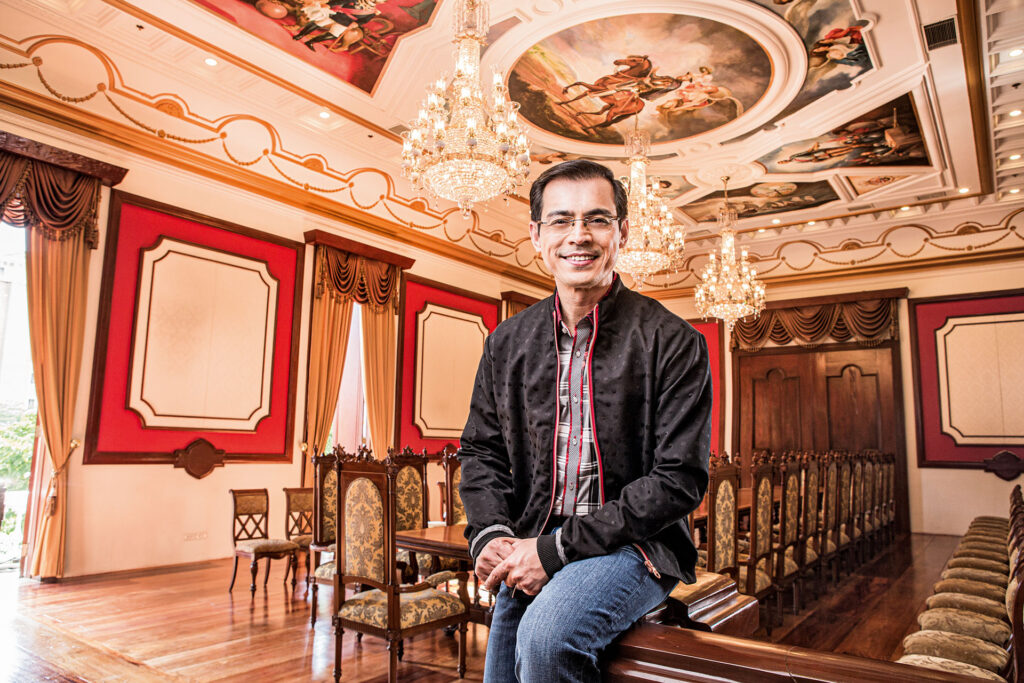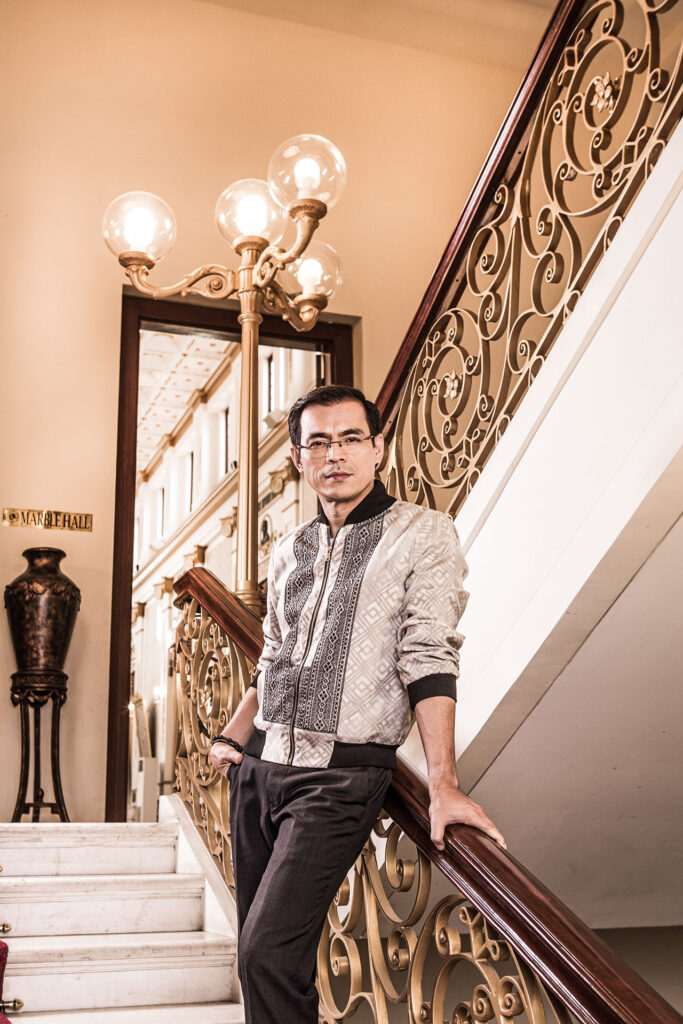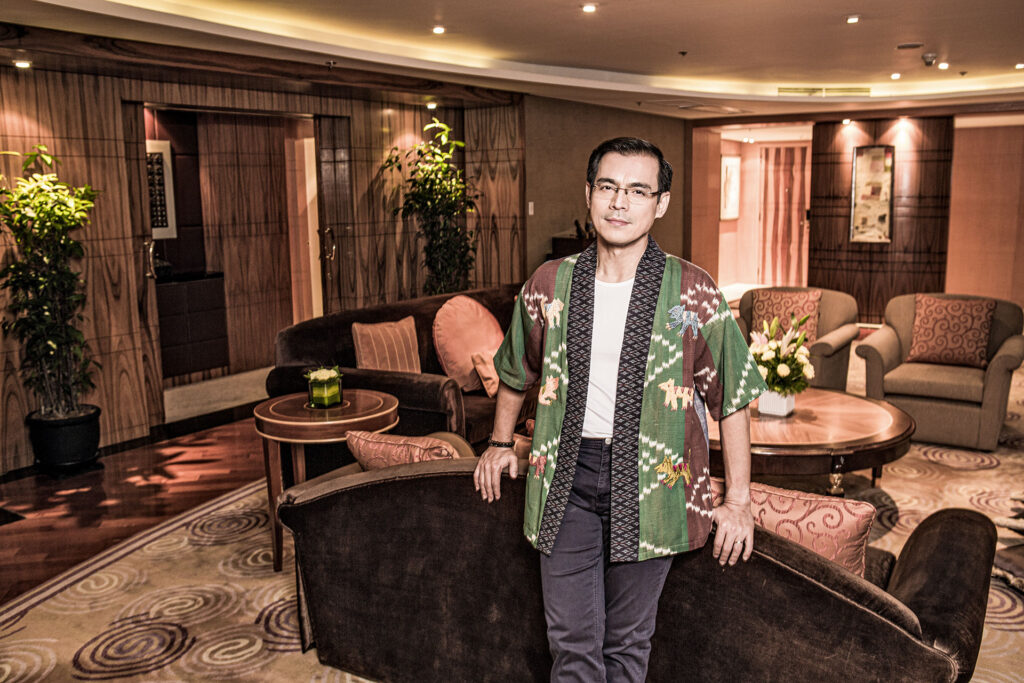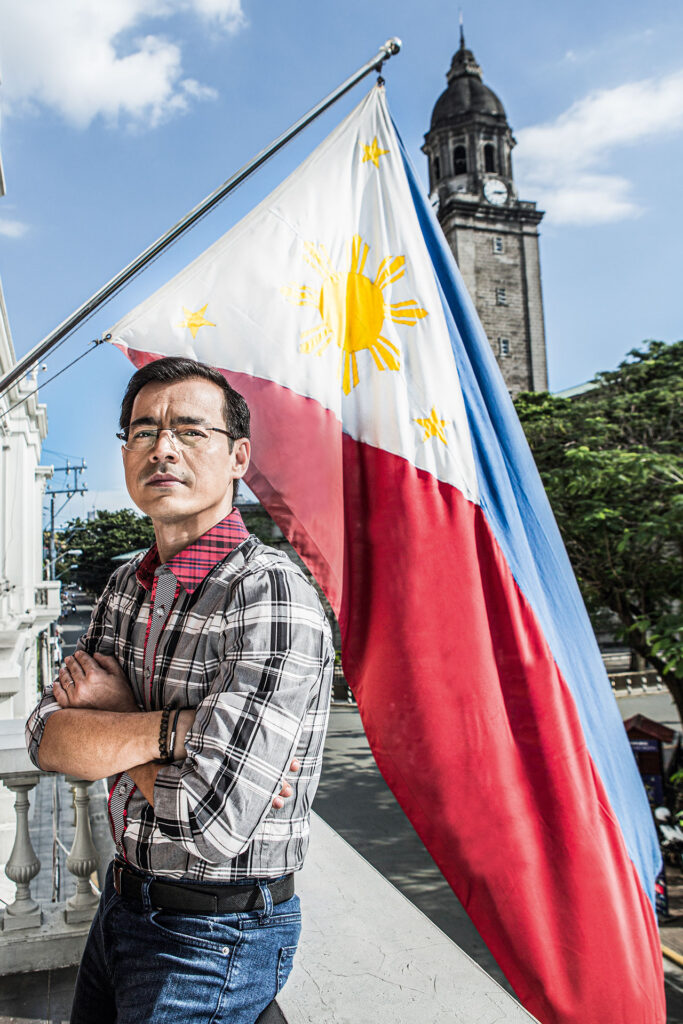By Jose Paolo dela Cruz / Photography by Mau Aguasin / Art direction by Ramon Joseph Ruiz / Styling by Luis Espiritu Jr. / Associate Styling by Diana Lasam, Tara Subaldo, Rudolph Leonor and Bang Martinez / Grooming by Erwin Oning
If New York is the city that never sleeps, then Manila has a mayor who never sleeps — on the job, at least. And it is for this very reason that the Philippine capital, after languishing for decades, finally catapults into the future with its eyes trained on being a world-class city.

(ON ISKO) Black polka dot bomber jacket and red plaid shirt by Randy Ortiz
In his younger years, Francisco Moreno Domagoso, along with his friends, would dive into the waters of Manila Bay. They would race to the bottom to catch coins that were being thrown by passengers from passing ferries.
It was a spectacle for the water farers,the cheap thrill of seeing these able-bodied boys jump into the breakwater and emerge with a glistening penny on hand a few seconds later. For the boys, it was all part of a day’s work.
“When you chase after a coin, you can’t grab it from the top. You have to race beneath it as it floats, then wait for it to drop at the palm of your hand while holding your breath underwater,” he says in the vernacular with a hint of nostalgia.
That boy has since grown to be Isko Moreno. The street-boy-turned-heartthrob, heartthrob-turned-mayor, and just recently, mayor-turned-social media superstar. What a journey it has been for him — for the city that he loves.
The great unravelling
Isko, on the eve of his 45th birthday, looks out to the setting sun from the Presidential Suite of the New World Manila Bay Hotel. He is now out of those waters, but is as immersed in the city as he has ever been. The height from the 12th floor fazes him for a bit, which he notes is odd since he used to jump from the decks straight into the water in his childhood days.
He points to his knee and traces his fingers along his thigh, where he says he once suffered a deep gash after brushing against some sharp corals. He brings with him more than the scars to this day.

Isko speaks with fondness, when asked about the Manila of his childhood. “It was not perfect, but far from what it is today. It has deteriorated,” he says. Manila, which once enjoyed the sobriquets of being Pearl (or Paris) of the Orient—depending on who you ask—the Rome of the East, due to its many lavish churches, had faded in decades past. Despite retaining its moniker of Imperial Manila, the country’s capital seems to have gone into a state of disrepair, earning for it a reputation for being unsafe and unclean. The Mayor even sites a report by the Department of Local and Interior Government, which placed it at the bottom of the list, as compared to the progress of its neighboring cities.
“Wherever we are now is simply the effect of what happened in the past decades. If there was stagnation during that time, if there was hibernation, then don’t expect that new things will come today. The question is what are we going to do today?” he asks.
Isko, along with his team, laid out a 10-year plan for the city. It is a vertical development program, which would cover infrastructure, the restoration (or at least, protection) of historic sites, tourism development and the opening of green spaces — along with a series of sustainable social amelioration programs. These, in the Mayor’s own words, are “no band-aid solutions.”
Isko, within his first 100 days in office, showed how resolute he is when it comes to restoring Manila to its former glory. In 48 hours, he solved a 20-year problem and effectively gave back the streets to pedestrians. Where there used to be endless arrays of stalls and circuitous, narrow walkways along Recto Ave. in Divisoria, there are now clean and cleared paths.
The shopping continues for Divisoria’s (and Quiapo’s) loyal horde of bargain hunters, but not the raucous setting that once made it a haven for snatchers, pickpockets and their ilk.
When asked if the change has stayed in place, Isko says this. “Ask me the day after tomorrow, visit today. That is our guarantee, that it’s going to be clean, itutuloy kung ano man ang naumpisahan namin (we will push through with whatever we have started).”
More importantly, the operations in Divisoria and Quiapo, which made headlines and catapulted Isko to national consciousness, didn’t even require much time, money and effort to begin with. All it needed was a decision to change things. “Wala naman akong ginawa. Hindi ko lang tinanggap (I actually did nothing. I just didn’t receive anything),” he says with a cryptic smile. “Put it this way. What are compelling reasons for the past administrations to not address the problem? There lies the answer.”
Past is never past
In bringing Manila to the future, Isko looks to the past.

Founded on June 24, 1571, by Spanish conquistador Miguel López de Legazpi, Manila is 448 years old today. It has been a city when the likes of Makati, Taguig, Muntinlupa and all its current neighbors were mere sitios in the once-sprawling province of Rizal. “Sayang talaga ang Maynila (Manila was really wasted). We have so many stories to tell,” says Isko.
The man knows his city’s history well. Inside the Ayuntamiento de Manila for instance, he points to the rough portions of the wall and tells us that these are “originals”—the only survivors from liberation of Manila. Thanks to the Department of Finance, however, Ayuntamiento (or the former City Council), was rebuilt and restored to look like its former self, complete with the Marble Hall where Congress used to convene; and the Sala de Sesiones, where the Spanish governor, the earlier Senate and previous mayors of the city held seats of power.
“I am currently being photographed in a historic building that was bombed, rebuilt and now used for various state functions. There aren’t many places like this anywhere in the country. That is the character of Manila. We are very fortunate to be here,” he says in the vernacular.
“We may not have tall skyscrapers or the most modern infrastructure, but one thing about Manila — and this is something others cannot copy — is that it has character!” he reiterates. Such a belief sets the tone for his leadership.
One exciting development that Isko talks about is the rehabilitation of Jones Bridge, an arched girder bridge that crosses the Pasig River. After being bombed during World War II for tactical reasons of isolating some parts of Manila, the bridge was later restored for functional purposes. However, the four “La Madre” statues that guarded its pylons, didn’t make it back home.
The three surviving statues foundthemselves perched in the Supreme Court, the University of the Philippines – Philippine General Hospital and Luneta. “We will build the pylons and retrieve the statues to bring them back to their original place,” he says, referencing the world-class Alexander Bridge in Paris as his inspiration. The three “La Madre” will also get a younger, 21st-century sister, a replica of the original. “It’s not going to be perfect, of course, but it will be beautiful,” he says.
The restoration of original edifices are also aplenty in the city, especially in Binondo, which is known for being the world’s oldest Chinatown. Chinabank in Escolta, for instance, has applied to revive the structure of its original art deco-inspired building to what it used to look like in the olden days. The Mayor also noted that he is in talks with Emil Yap, who will work on the restoration of the old Philtrust Building. It will be painted, lit and rejuvenated to give it the attention it deserves in modern times.
Giving back to the people has also inspired partnerships between the public and private sectors. “Kahit ano pang pangarap namin, kung gusto man namin ng ganito or ganyan, wala kaming magagawa kung privately owned (no matter what we aim to achieve, we can only do so much if certain properties are privately owned). But that doesn’t stop us from working together to make the city more pristine, more charming,” says the Mayor.
More importantly, in these private players, he found likeminded visionaries. Apparently, so many have wanted to restore Manila to its former glory. The only thing missing was a leader who thought the same.
Public interest
As for public spaces, the Mayor and his allies are working non-stop to develop and ensure the integrity of Manila’s remaining government-owned assets. Arroceros Forest Park, for instance, has been protected and has been legally safeguarded. It will never be sold, despite reported attempts to sell parts of the 2.2-hectare park in the past.
Other places on Isko’s list include Plaza Rueda, the Kartilya ng Katipunan Shrine, the Mehan Garden in Lawton, Binondo and more. Not only will these places be lit up, but security will also be added to encourage the public to visit these green, open spaces.
The Mayor also intends to take advantage of Manila’s fluvial assets, the Manila Bay, which is healthier now than it was in the past few decades; and the creeks and canals that weave themselves into the inner parts of the city. “We have water on the west side, we have creeks and waterways that, once developed, will be comparable to the ones we see in Amsterdam, Venice, Texas and the San Antonio Creek in California,” he says.
A sky deck will also be built along Manila Bay. With this, guests from neighboring hotels, as well as visitors to the city, can finally enjoy safe and spectacular front-row seats to the city’s iconic sunset.
Shaping a people
With cleanliness and infrastructure in place, Isko also notes that “culture is part of governance. It’s our sense of belonging on the line. It’s what makes us know where we came from,” he says.
In line with this, Isko is very excited about the city’s collaboration with the Department of Tourism and the National Commission for Culture and the Arts. The two are currently working on the renovation of the Manila Metropolitan Theater. Once completed, the Manila Metropolitan Theater will be the city’s answer to the Cultural Center of the Philippines—a world-class theater that is able to retain its old world charm as an art deco edifice, and equip itself with modern facilities for staging shows that are relevant to the people. “The only way to remind the generation of who we are, is to portray it,” he quips.
So happy is Isko on the recent developments of the theater, that the city donated a parking lot to complete it once it opens.
But of course, culture, and mindsets and perceptions are not all dealt with onstage. Isko notes that it frustrates him to see pedestrians still jaywalking despite the clearing of existing structures such as the Lacson Underpass. It irks him when he sees people littering despite the abundance of trash bins and the more regular schedule of garbage trucks. He says that while there are improvements, it will take time before the people of Manila, as a whole, realize that they are part of the change they seek.
“We have been so accustomed to these challenges, to being in this state, that we have accepted the abnormal as normal. We have to bring back the normal to normal. In our own little way, we’re trying also to change the mindset of the people. As you can see, were trying also to make ordinary people, the Johns and Marys, or Juan Dela Cruz and Petras to be part of our efforts,” he says.
To spread awareness, the Mayor made his Facebook account public, so that he can address the concerns in real time. He answers their questions, acts on their complaints, and yes, blocks bashers. “I open up my channel to talk to people and you use it for bashing, goodbye!” he says with a smile, and a tap of the finger.

As the shoot wraps up and the PeopleAsia ENCLAVES team prepares to call it a day, Mayor Isko Moreno reveals that the night is still young for him. He would, later that evening, find himself in Tondo, enjoying a public concert with his beloved constituents.
It is not unusual for the hard-working public servant to work late hours. At one point, in fact, he reportedly fell asleep till the wee hours in a hotel lounge due to exhaustion. Despite the mayor’s rock star status, those who saw him restrained themselves from taking pictures, hushed their voices and let the man catch a few winks. Even the pianist lowered the music. They simply let him be.
For in Mayor Isko’s case, rest isn’t for the weary. It’s for a man who’s getting ready to take on another day.
This story first appeared on PeopleAsia Enclaves October 2019 issue. Did you like what you’ve just read? Let us know in the comments section below.





